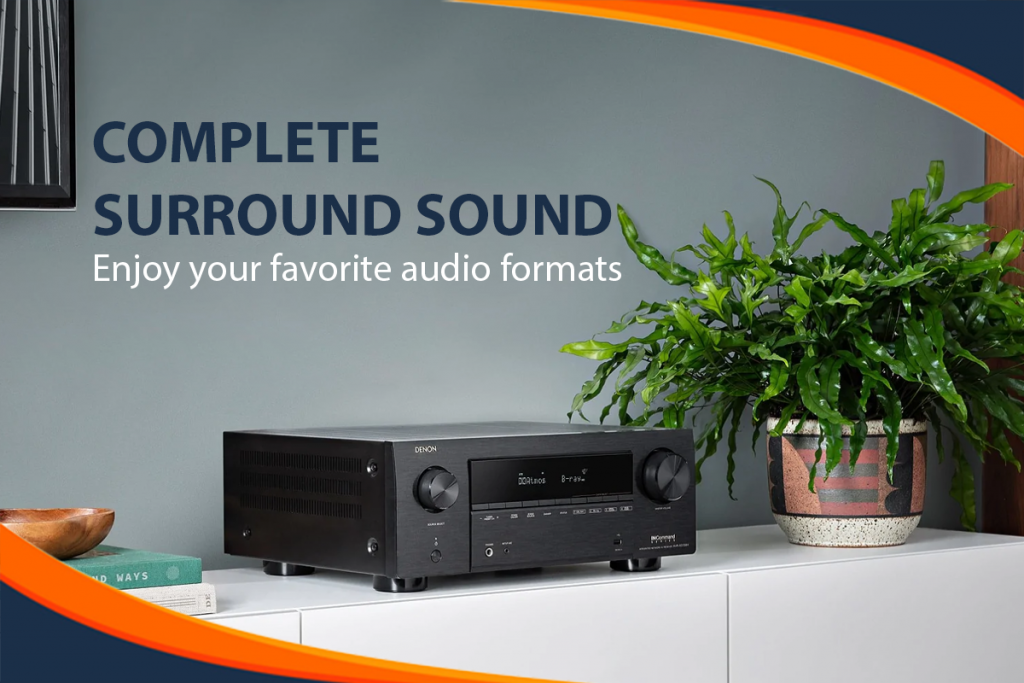Denon AVR-S760H
PROS
- Great audio output
- Full 40Gbps HDMI 2.1 ports
- Plenty of features
- Low price
CONS
- Not very powerful
- No front HDMI input
- Audyssey MultEQ Editor app not free
- No backlight on remote
While the main bulk of Denon’s X series saw their latest update in 2020, with the infamous HDMI 2.1 bug these came with, it was not until the last months of 2021 that Denon updated their more affordable S series with two new models in order to complement the already released AVR-S960H. The AVR-S760H and AVR-S660H with 7.2 and 5.2 channels respectively come with plenty of features, even for their low cost nature, and are priced just under the S960H and X1700H. And so in today’s Denon AVR-S760H review we will be testing this new AV receiver in the S series to see if it is a worthy continuation of the previous lineup.
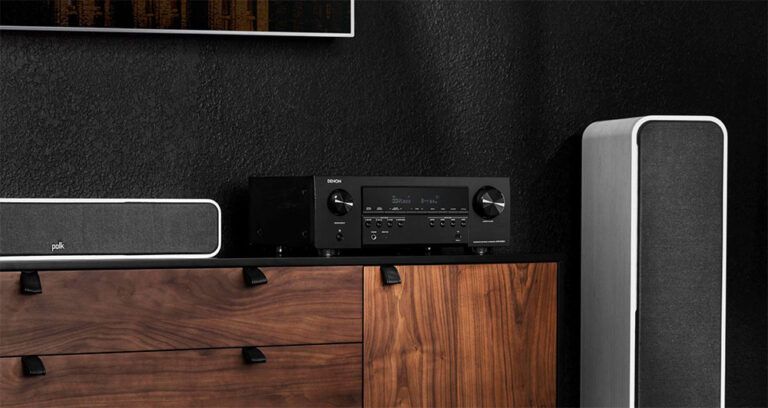
Now, many of you may be wondering what the differences are between the AVR-S760H, the S960H and the AVR-X1700H since all three of them are 7.2 channels AV receivers and all three have awfully similar characteristics and features. So in this review while we will be looking at the AVR-S760H specifically we are going to mention the differences this one has compared to the rest, even though these seem to be very hard to discern upon first look.
So what the AVR-S760H brings to the table? As we mentioned, the receiver has 7.2 channels of built-in amplification with 75 watts of power per channel, supports Dolby Atmos and DTS:X along with the usual virtual and up-mixing tech like Dolby Surround, DTS Neural:X, Dolby Atmos Height Virtualization and DTS Virtual:X, comes with the basic version of Audyssey called Audyssey MultEQ auto calibration system and comes with plenty of extras like High Resolution Audio, HEOS technology, AirPlay 2, voice control, custom integration as well as HDMI upscaling and fully working HDMI 2.1 ports.
The biggest selling point of the AVR-S760H seems to be its three, 40Gbps capable HDMI 2.1 ports which makes the current model an ideal low cost solution for any gamer. The S760H has limited power output so it is not meant for big home theaters but for smaller gaming rooms or entertainment areas it seems to be an excellent choice. Is it indeed as good as it looks? Let’s start our analysis to find out…
Design
When it comes to its design and looks, well… this is a Denon so don’t expect any big differences compared to previous years. In fact the AVR-S760H has retained the outer shell of previous models without any difference at all with the only exception being the missing front HDMI port which seems to be the standard lately. For some reason the arrival of HDMI 2.1 made these manufacturers take out the front HDMI which is a shame really and we do hope they will bring it back in the near future.
But except from that everything else has remained the same and the unit measures 17.1″ x 13.3″ x 8.5″ (434 x 339 x 215 mm) with the antennas in vertical position. You can slightly minimize its height to 6″ (151 mm) if you turn them horizontally without any loss on wireless quality and thus strikes a perfect balance between size and capabilities. The size of the receiver is just about what you should expect from its category so no real surprises here.
In real Denon fashion the outer shell is featuring straight lines and sharp corners as this is your typical black box receiver that sounds much better than it looks. The front features a brushed metal texture with an exact shame layout as the 2019 releases.
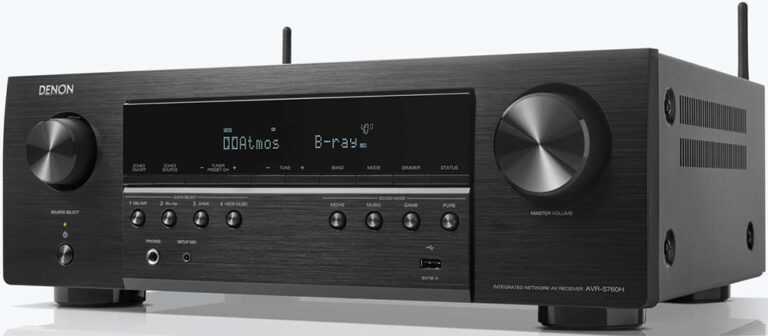
This means a big central display showing all functions with two big circular knobs at each side for volume on the right and source selection on the left. Under the source selection knob we find the power button while a thin line under the central display houses 10 function buttons that include tuner and zone 2 controls, Dimmer, Status and two groups of four circular buttons underneath with one group being the quick selection buttons and the other the sound modes.
Under these buttons, as usual, we get the front ports with the headphones jack and setup microphone port on the left and a single USB port on the right that can be used to stream audio from a USB based external storage like a flash drive. Next to the USB used to be the front HDMI port but the arrival of HDMI 2.1 seems to be the reason for taking this out of almost all new low and middle tier releases. Let’s hope that manufacturers will bring this back in the future as it was a very practical port to have for easy and quick access and we totally disagree with them taking this out.
When it comes to its internal hardware we don’t find much difference from other similarly priced Denon units either. The receiver features discrete high-current amplifiers on all channels with low-impedance drive capability while it’s 32-bit D/A converters allow for high resolution audio decoding while providing low distortion and the widest possible dynamic range. The AVR-S760H also features an advanced DSP (Digital Sound Processor) chip that includes four 300MHz DSP cores allowing it to support the latest surround sound mixes and meet all required processing needs.

The remote we find with this unit is code named RC-1244 and looks very similar to other Denon remotes, design wise, but has a few differences mostly on the functionality of some of its buttons. The remote comes with all the input buttons at the top along with the HEOS and Bluetooth functions, navigation buttons in the middle along with channel and volume controls while playback, quick selection and sound mode buttons are being placed at the bottom.
The remote in general is a big one while the buttons have a relatively small size and we would like them a little bigger to be easier to the touch. At least the long distance between them minimizes the risk of a wrong command which can be a regular phenomenon in a dark environment since the remote lacks any kind of backlight functionality. Its construction is good and feels pretty solid with a nice texture on top to make it look a little bit more premium.
The new AVR-S760H remains faithful to its manufacturer’s standards. This is a typical Denon design with all its pros and cons and you shouldn’t expect to find anything different. In terms of looks it’s the same old design on the outside while on the inside there are some specific changes but key components have remained the same. The remote also has a few changes from previous years but at some point we hope to see some short of smart remote in the same way that some smart TVs are using their UIs instead of having to rely on huge number of buttons for their functionality.
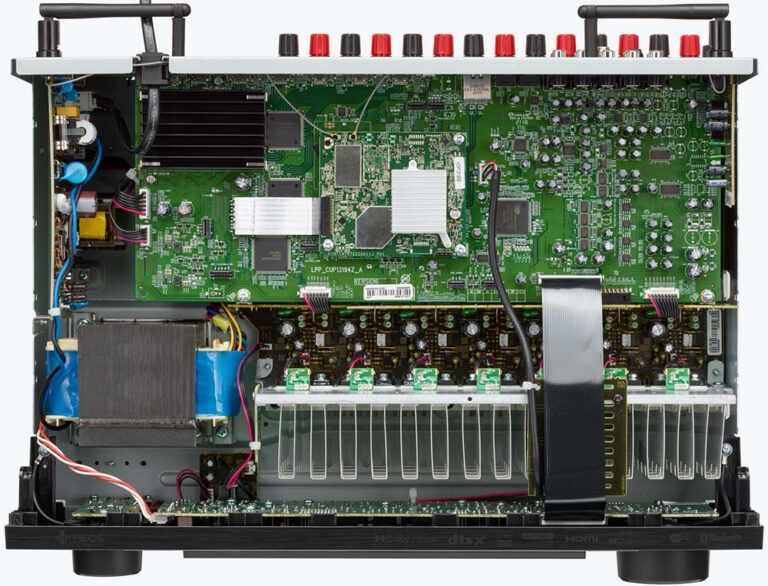
Audio Quality
The receiver supports the usual Dolby Atmos and DTS:X object oriented audio tracks but along with these we get support for up-mixing and virtual technology features in order to cover all needs and specific room configurations.
When it comes to up-mixing tech we find the usual Dolby Surround and DTS Neural:X. What these up-mixing tech are doing is to up-convert stereo and legacy mixes in order to make use of all the speakers you have in your setup. As for virtual tech the DTS Virtual:X is capable of creating sounds that originate from virtual created speakers around your room where there are no physical speakers present.
This virtual tech obviously is not as good or accurate as having real physical speakers and are very much room dependent. Also the sound many times can be heard very over-processed something we were never very fond of. If there is anything missing here that would be Auro-3D along with IMAX Enhanced as both of these are kept only for the higher tier releases in the X-series.
Being an entry level unit, part of the S-series, the AVR-S760H comes with 7 channels of built-in amplification and each channel can pump 75 watts of power (8 ohm, 20 Hz – 20 kHz, 0.08% 2ch drive). As always you should not be fooled by this number as manufacturers always give ratings with only 2 channels driven meaning that when all 7 channels are active this number goes down considerably.

With the supported channels you can go all the way for a 5.2.2 channels audio setup with two dedicated overhead speakers for maximum immersion. For our test we went for a 5.1.2 setup using a single subwoofer and 2 Atmos ceiling speakers placed at the middle of our viewing area.
For this review we started with all out mayhem with the 4K UHD version of Transformers: Dark of the Moon with its wall shattering Dolby Atmos mix. The film needs no introduction so we will skip right into our observations of the receiver and to be honest there was nothing that could indicate that the S760H is in fact a low cost release.
Transformers is obviously the kind of film that relies a lot on wide open battle scenes and total urban destruction so there are a lot of panning shots and sound effects that traverse the sound stage from all sides. The Denon did a great job in all axis. At the front the sound wall was really expansive giving you the illusion of a wider and deeper area while the precision of the surround channels gave you a clear indication of the action behind the camera.
Dialogue was nicely isolated at the center and everything was easy to understand even during moments of intense action. There was no overlapping between the actors voices and the rest of the audio and even the transformers voices with their electronic tone were crystal clear and of high quality.
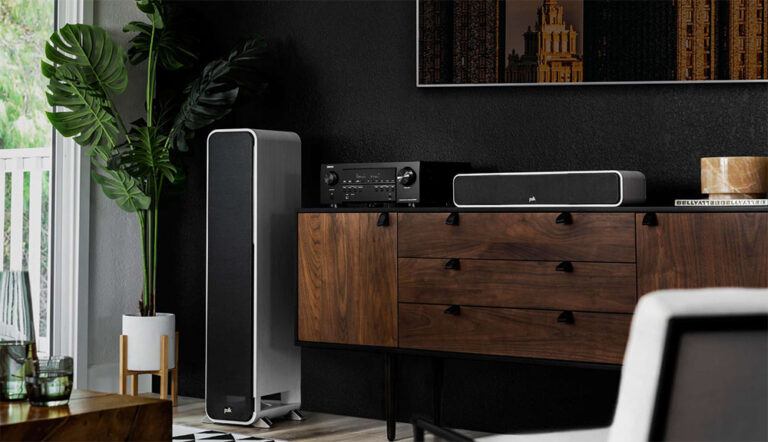
The overhead layer was pretty busy with the ceiling speakers adding some height to the immersion bubble but keep in mind that with Atmos there are a lot of factors that will determine the actual results you are going to get. But with our setup the receiver was exceptionally good at pushing the limits over our heads. Gun fire, fighter jets, rockets and literally anything that could fly went past our heads with extreme precision across multiple channels.
The surrounds did equally good and there was no moment where we felt that dimensionality was lost. On the contrary the Denon kept very stable even during more intense fight scenes where a lot of information can be lost. The bass was absolute phenomenal and the SVS SB-1000 Pro we had for this test was like a playful child during the scenes we were testing. The receiver had no problems here either and the low end was vigorous and full of energy, without choking or feeling muffled.
As for our next test we tried to resist our urge for some Lord of the Rings action but alas we felt like weak puny humans and in the end we went with The Return of the King in 4K UHD and its flooring Dolby Atmos sound. We skipped right into the last act of the film with the Siege of Minas Tirith and the Battle of the Pelennor fields being the most epic battle seen in recent cinematic history.
The S760H did excellent here also. The sound of the Rohimir horses as they galloped towards Sauron’s vast army brough chills up our spines. The Earth shaking Mumakils when the Haradrim joined the battle spelled doom for men while the arrival of the Army of the Dead was eerie and ominous.
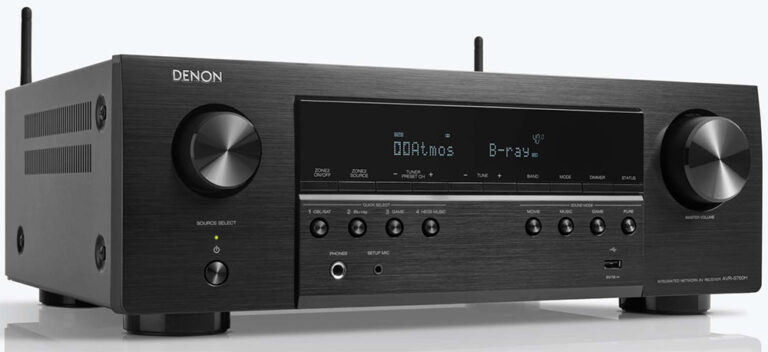
With the camera staying close to the ground and a lot of action happening in all directions the Denon did wonderfully with the surround action and you had a very clear idea what was happening across the entire battlefield. Dialogue once again was nicely kept at the center without mixing with the rest of the action. Bass was powerful, clear and kept the action going. Atmos effects may not be as obvious in this film but still the ceiling speakers provided moments of overhead extension adding even further to the immersion.
In total we were very impressed with the receiver. If there was one area where it looses a few points that would be its max volume. In normal levels the receiver showcased noteworthy balance and masterful handling of all frequencies. Only when we pushed it to its limits some of this balance was slightly lost. Most probably you are not going to push such a receiver so much but this shows that its limited power output has a negative effect on the quality it can produce when pushed too much.
Naturally High Resolution Audio couldn’t be missing so except from the usual low quality MP3, WMA and AAC the receiver can also playback FLAC, ALAC and WAV files up to 192 kHz / 24-bit as well as DSD for both 2.8 and 5.6 MHz. In our case, as we always do in our reviews, we selected a few music tracks in FLAC format that we streamed through the USB port of the receiver for the best possible quality.
And for that we switched to a 2 channels setup which is mostly preferred when listening to music. As we always say it is not only a matter of how good the AV receiver is but also with what kind of speakers you are going to pair it with in order to get the best of results.
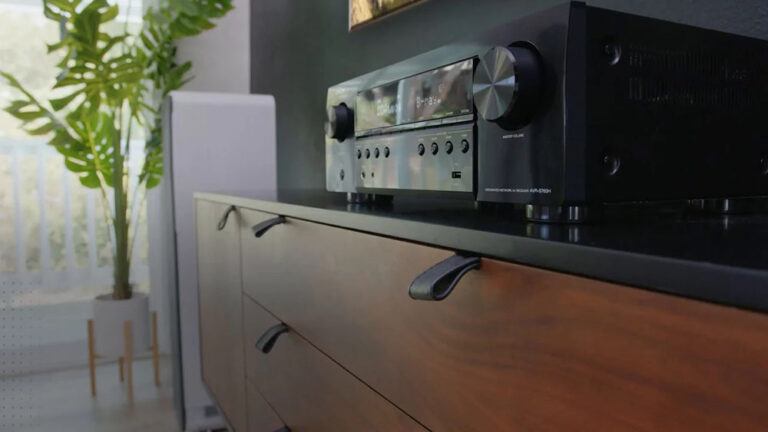
For such a budget receiver the S760H has nothing to be jealous compared to some other more expensive offerings. Sure, it may not have the powerful output but if you don’t tend to push the volume to extreme levels then the receiver is going to play nice and perform admirably. The music stage in front of us was full of energy and the tinniest of details were delivered to our speakers.
Going through various genres including a few heavy metal songs, some Jazz, classical, and a few electronic selections the S760H was able to render all of them with great precision and control over the entire frequency spectrum. Yes, the receiver may not go to the extremes like some top premium offerings but you have to think about how much higher in price you have to go to understand any meaningful difference.
Obviously the AVR-S760H is not audiophile material but such a receiver is not meant to be. And if you are a casual user that plans to use this for mixed content then rest assure that it will not disappoint you in any way. And with music specifically it will provide you with countless hours of musical enjoyment.
The AVR-S760H seems destined for a very specific role. And this becomes apparent by two factors, its more or less limited power output and its fully capable HDMI 2.1 ports. These two factors make the S760H an excellent receiver for relatively small areas, either it be home theaters or gaming rooms and in both cases there is hardly anything better out there at the moment for you to get. With its great audio performance that is equal to many other models with much higher price tags the Denon is surely a good one for consideration.
Ports and Connectivity
Usually when it comes to yearly releases manufacturers don’t change much in terms of connections. Either they make slight alterations or they leave things exactly the same. The AVR-S760H, upon first look, seems to have a very similar layout to the previous S750H but there is one major difference that we already mentioned above.
First of all we already mentioned above about the frontal ports that include the Headphones jack, the setup microphone port and the USB port. Here we have lost the front HDMI input so we are one HDMI port minus here.
At the back of the unit the first thing that catches the eye are the 7 speaker terminals placed in a straight line at the bottom which helps a lot with cable management. The terminals are the usual quality we have seen from Denon so all is good here with good quality plastic caps while each terminal has its own amplification.
At the top we find the HDMI inputs and here we find six of them instead of five on the S750H. So in essence they took the front HDMI port and placed it at the back which is a bit puzzling to be honest if you ask us. But the interesting fact here is that while the S760H is a low priced model it actually comes with three fully working HDMI 2.1 ports and another three that are the older HDMI 2.0 type.
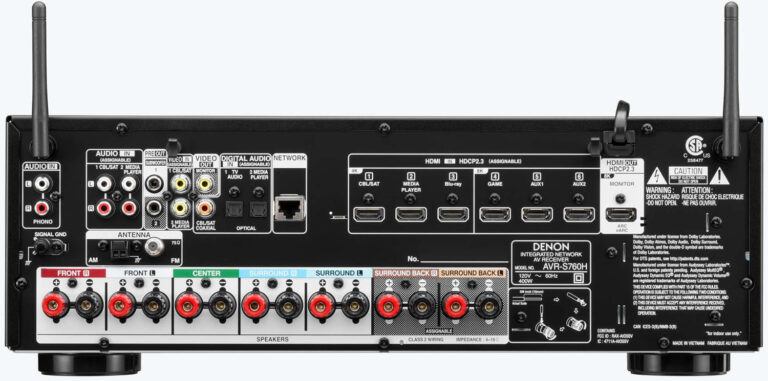
As for the rest of the connections we get the same 3 composite video inputs and 1 output, 2 optical and 1 coaxial digital inputs, 1 Ethernet port, 0.2 channels pre-outs, 2 analogue audio inputs and one more dedicated for phono and the usual FM/AM antenna inputs along with the WiFi/Bluetooth connectors.
The only differences we find here between the S760H and the X1700H is the latter has an extra IR input along with a Zone 2 pre-out that the S760H is missing.
As for the three HDMI 2.1 ports these support all the old and new exciting technologies including 8K/60Hz and 4K/120Hz video passthrough, 40Gbps bandwidth, 4:4:4 Pure Color sub sampling, HDR10, HDR10+, Dolby Vision, Hybrid Log-Gamma (HLG), Dynamic HDR, 3D, BT.2020 pass-through, Quick Media Switching (QMS), Variable Refresh Rate (VRR), Auto Low Latency Mode (ALLM) and Quick Frame Transport (QFT).
As you probably guessed from the above is the fact that the AVR-S760H comes with the new unaffected HDMI 2.1 ports. All the 2020 AV receivers that featured HDMI 2.1 ports came with a bugged Panasonic chip that wouldn’t allow it to pass certain signals, like 4K/120Hz RGB signals from the Xbox series X for example as it would result in a black screen. Also all these HDMI 2.1 ports had a limit of 32 Gbps bandwidth or less which would prove a potential bottleneck with certain high bandwidth signals.
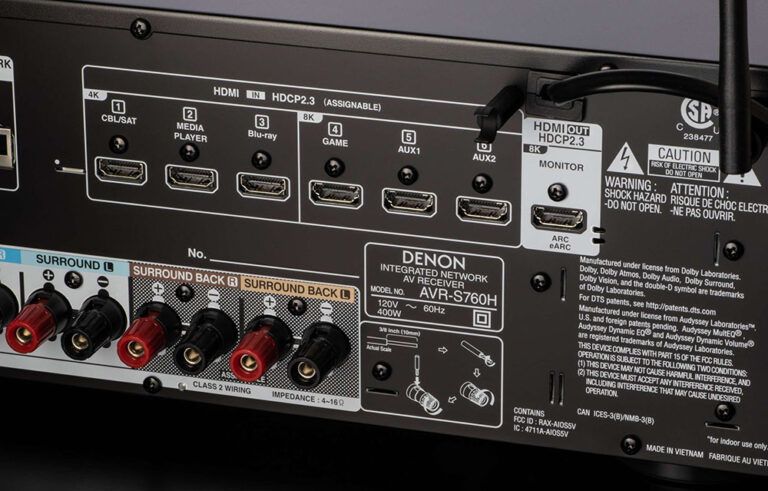
The AVR-S760H on the other hand seems to be using an updated version of this HDMI 2.1 chip which allows up to 40Gbps of bandwidth in three of its HDMI ports and this includes all the signals with a 4K@120Hz configuration including Xbox Series X.
Just for the sake of it we did connect an Xbox series X and our test TV indicated that we were getting 4K@120Hz with VRR at 40Gbps signal bandwidth once again. During this test we didn’t experience any HDMI problems and the signal was completely stable throughout the playing session.
As for the unit’s wireless capabilities we get built-in WiFi which can connect both in 2.4GHz and 5 GHz networks while it also supports Bluetooth streaming. The AVR-S760H supports Bluetooth 4.2, as most Denon receivers, which is not as efficient as the newer v5 but at least during our testing we didn’t notice any lagging or connection problems.
The AVR-S760H may be a low budget offering but its three fully working HDMI 2.1 ports surely is its strongest point and we see many gamers choosing this one for this exact reason. Obviously in the future we expect manufacturers to include even more fully working HDMI 2.1 ports but even three are enough by today’s standards. If there is one thing we will keep complaining about is the missing front HDMI port. Let’s hope our wish will be heard in the future.

OS, Apps and Features
Next we will be looking at all the extras that Denon has included. The last couple of years there are not any major changes in terms of extra features as most of their offerings are already fully packed so this section of our review will be very similar to other Denon reviews and we will be making changes and additions wherever we deem necessary.
First of all we will talk about the audio calibration system. Denon is using the Audyssey system and as with all manufacturers they scale it accordingly to meet the price and performance standards of each of their models. The AVR-S760H is using the most basic version called the Audyssey MultEQ which is a step lower than the more advanced XT version found in the X1700H. In comparison this one features lower resolution filters which can result in less accuracy.
The Audyssey MultEQ comes also with Dynamic Volume and Dynamic EQ. Dynamic EQ is a feature that is responsible for keeping the clarity and dynamic levels of audio even when you like to watch at low volume, like for night viewings for example. Dynamic Volume on the other hand is capable of balancing sudden changes and spikes in volume that could appear when there are sudden changes from TV broadcasting to commercials.
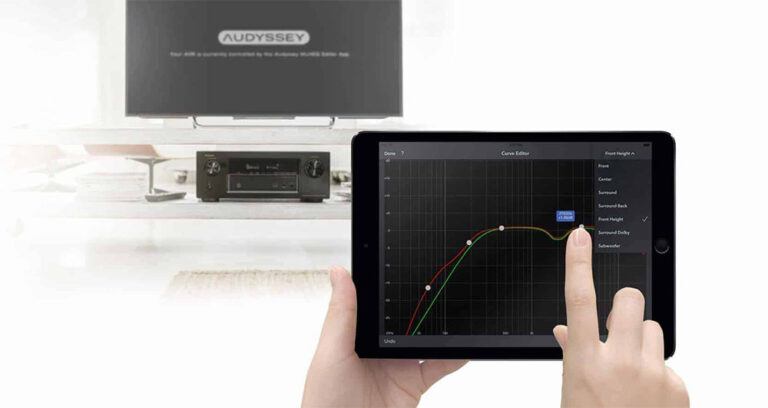
Going through the Audyssey calibration can be done either through the built-in wizard or if you want to dive deeper into calibrating your system then you can download the Audyssey MultEQ Editor app that is available for Android or iOS and do a more thorough setup with the help of your mobile device. Only keep in mind that this app has a one time fee which is a shame but it is what it is. As for the built-in system this is more than enough for most casual users as it offers almost anything you need to make very good and precise adjustments to your system.
But Denon provides another app for this AV receiver and this one comes completely free. The Denon 2016 AVR Remote app as it is called lets you control the unit with your mobile device through a nice visual interface. If you are tired of the included remote this is a nice and most important free alternative. The app is available for both Android and iOS devices so we suggest you give it a try to see if you like it.
When it comes to the User Interface the one in this unit is pretty simple and straightforward and similar to what we had seen in other Denon receivers so no surprises here either. Although it doesn’t have the visual impact of some other UIs we have seen used in TVs for example it’s layout is very nicely done and you can find all the settings you will need without much effort.
The receiver comes with the usual streaming as well as multi-zone capabilities that Denon includes in almost all their units. As it supports both HEOS and Airplay 2 you can either stream music online from one of the available online streaming services that include Spotify, Pandora, Amazon Music HD, TuneIn, SoundCloud, SiriusXM and TIDAL among others or create your own multi-room environment with the use of appropriate wireless speakers.
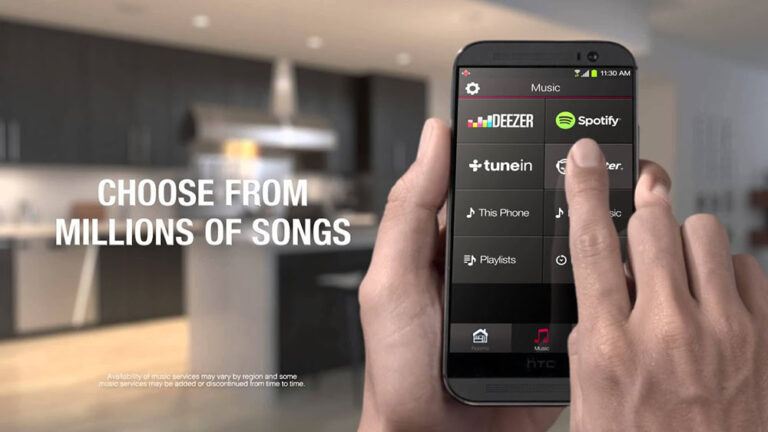
Both the HEOS and Airplay 2 apps are available for downloading from their appropriate stores for use with your mobile device. But if you prefer a wired connection the AVR-S760H also supports Zone 2 for your convenience but keep in mind this will limit the number of channels you can use in your main room.
Now as far as streaming, online is not the only option you have as you can stream audio from a network drive or NAS server if it happens you to have one connected to your local network. Also with the included USB port you can stream music through some connected external storage or flash drive. Lastly if you prefer a more wireless way of streaming your music there is Bluetooth available for connecting with your mobile device. If you use Apple devices then Airplay 2 can also be used to stream music wireless through it.
And since we mentioned Bluetooth another function that is included in the S760H and seems to become a standard is that the receiver can output audio in two different ways using its Bluetooth transmitter. The S760H is capable of streaming audio to Bluetooth enabled headphones for a completely silent house experience or it can also output sound from both its speaker terminals and to a Bluetooth headset. This can be particularly practical in case there is a member in the family that is hearing impaired.
Denon is known for including all known voice control platforms to most of their models and the S760H is not any different in this regard. As such there is support for both most known ones with Amazon Alexa and Google Assistant but there is also support for Apple’s Siri through the Airplay 2 app and the advanced automation system Josh.ai making this receiver complete in every way.

Another handy feature that we do find is HDMI-CEC and this one lets you use the TV remote to control the AV receiver if the TV also supports this. You can understand the practicality of this as this way you can reduce the amount of remotes you will need to have in your home theater. Obviously this feature lets you use only the most basic functions of the receiver but for everyday use it can be a very time saving one.
But extra features don’t end here so let’s see what else is included. The receiver supports video upscaling to 8K resolution but the limitation here is that the S760H can do that only through its HDMI ports and not from analog to HDMI. We also get an ECO mode that can regulate the receiver’s power usage for a more environmental friendly power consumption, custom integration for Domotz Pro and OvrC as well as being “Roon Tested” certified.
For this last one there seems to be a bit of confusion as there are two types of certifications. Roon Ready and Roon Tested. The AVR-S760H, as with many other similar receivers like Marantz, is Roon Tested which means while Roon will work on this unit you will not get the highest quality possible. So for example if you use Airplay, audio quality is limited to 16 Bit/44.1kHz. Keep that in mind in case Roon is specifically important to you but also want your files to be streamed in their original quality.
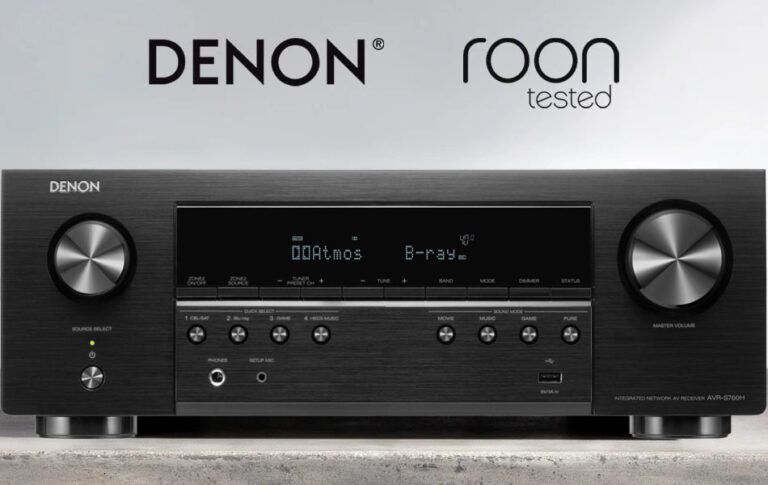
Final Thoughts
Since many of you asked which of the X1700H or S760H to go for, what we can say is that for about $100 less the AVR-S760H has slightly less power, an inferior Audyssey system, no bi-amp capabilities, no IR input, no zone 2 pre-outs and an inferior warranty. If these omissions are no big deal for you then we strongly suggest you to go for the S760H and save some buck as there are no other noteworthy differences between the two.
The AVR-S760H is a very intriguing AV receiver. It may be classified as a low cost offering but the amount of features it comes with is really staggering. Performance wise is as good as you would expect from a 7.2 channels AV receiver. Its feature set is missing nothing important while its connectivity capabilities is surely one of its most strong aspects. By having three fully working, 40Gbps capable, HDMI 2.1 ports this receiver is an excellent choice not only for small entertainment areas but also for more advanced gaming rooms.
As for its downsides there is really nothing major to talk about when you consider what you pay for. The missing front HDMI port is surely one while we would love to see a simpler remote complementing a better UI. Also Denon is not making it easy for consumers as many of their releases are priced really close to each other like the S760H, the S960H and the X1700H. This makes these models really hard to tell apart and which one to choose from, with many of our readers that have asked this exact question revealing the problem. Lastly this is not the most powerful of receivers so it may have trouble in bigger rooms.

The Denon AVR-S760H is an excellent AV receiver that is ideal for anyone looking for a low cost model that can be used for either a small home theater or entertainment area or for a gaming system without worrying about the HDMI 2.1 problems of the past. Denon seems to have delivered and thus we give our highest recommendation.
You can find more of our AV receivers reviews in our dedicate section HERE. Also don’t lose the chance to subscribe to our Newsletter and gain exclusive privileges.

